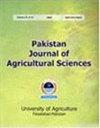不同叶锈病治理下面包小麦先期品系形态生理及产量性状的多变量分析
IF 0.6
4区 农林科学
Q3 AGRICULTURE, MULTIDISCIPLINARY
引用次数: 2
摘要
叶锈病在全球多个国家影响小麦作物,影响粮食产量及其组成部分。本研究在2016-2017年生长季使用35个小麦基因型,在不同的锈病制度下使用RCBD进行3个重复。用于多变量分析的统计技术包括相关性、主成分和聚类的计算。在高病压和最高病控条件下,记录了水稻各生理性状、产量组成和病害严重程度的数据。相关分析表明,病害严重程度与相对膜透性呈极显著正相关,与旗叶叶绿素含量及部分产量性状呈极显著负相关。对照条件下,相对含水量与旗叶面积呈极显著正相关,而病害条件下,相对含水量与旗叶比重呈极显著负相关。主成分分析表明,在患病和对照条件下,特征值为>1的前4个个体分别解析了总变异的73.578%和82.80%。聚类分析将35种小麦基因型分为4个不同的聚类。在控制条件下,集群1成员的疾病严重程度最大,而在疾病条件下,集群4成员的疾病严重程度最大。散点图解释说,没有一个集群显示出明显的分离。树形图还表明,不同疾病条件下的多样性受基因型控制。结果表明,这种遗传多样性有助于研究人员和育种人员今后提高面包小麦的粮食产量和叶片抗性。关键词:小麦,叶锈病,多变量分析,遗传多样性,形态生理性状本文章由计算机程序翻译,如有差异,请以英文原文为准。
Multivariate analysis of morpho-physiological and grain yield traits in advance lines of bread wheat under different leaf rust disease regimes
Leaf rust disease affects the wheat crop in several countries around the globe and it can influence the grain yield and its components. This research was carried out using 35 wheat genotypes during the growing season of 2016-2017 with 3 replications by RCBD under contrasting rust disease regimes. The statistical techniques used for the multivariate analyses include the calculations of correlations, principal components and clusters. The data about various physiological traits, grain yield components and disease severity were recorded under high disease pressure and maximum disease control conditions. Correlation analysis showed highly significant positive relationship of disease severity with relative membrane permeability but negative association with chlorophyll contents in the flag leaf and some yield attributes. In control conditions, the relative water content exhibited a highly significant positive relationship with the flag leaf area while highly significant negative relationship was observed with specific flag leaf weigh under disease condition. Principal component analysis demonstrated that first 4 PCs having eigenvalue >1 elucidated 73.578% and 82.80% of the total variation under diseased and control conditions respectively. Cluster analysis grouped 35 wheat genotypes among four different clusters. The members of cluster 1 revealed the maximum disease severity under control condition, but the disease severity was maximum for cluster 4 under disease condition. Scatter plot explained that, not a single cluster showed clear separation. The tree diagram also indicated that diversity in different disease conditions is controlled by genotypes. The results concluded that this genetic diversity could be helpful to the researchers and breeders for future objectives to enhance the food production and leaf resistance in bread wheat. Keywords: Wheat, Leaf rust, Multivariate analysis, Genetic diversity, Morpho-physiological traits
求助全文
通过发布文献求助,成功后即可免费获取论文全文。
去求助
来源期刊

Pakistan Journal of Agricultural Sciences
AGRICULTURE, MULTIDISCIPLINARY-
CiteScore
1.80
自引率
25.00%
发文量
18
审稿时长
6-12 weeks
期刊介绍:
Pakistan Journal of Agricultural Sciences is published in English four times a year. The journal publishes original articles on all aspects of agriculture and allied fields.
 求助内容:
求助内容: 应助结果提醒方式:
应助结果提醒方式:


